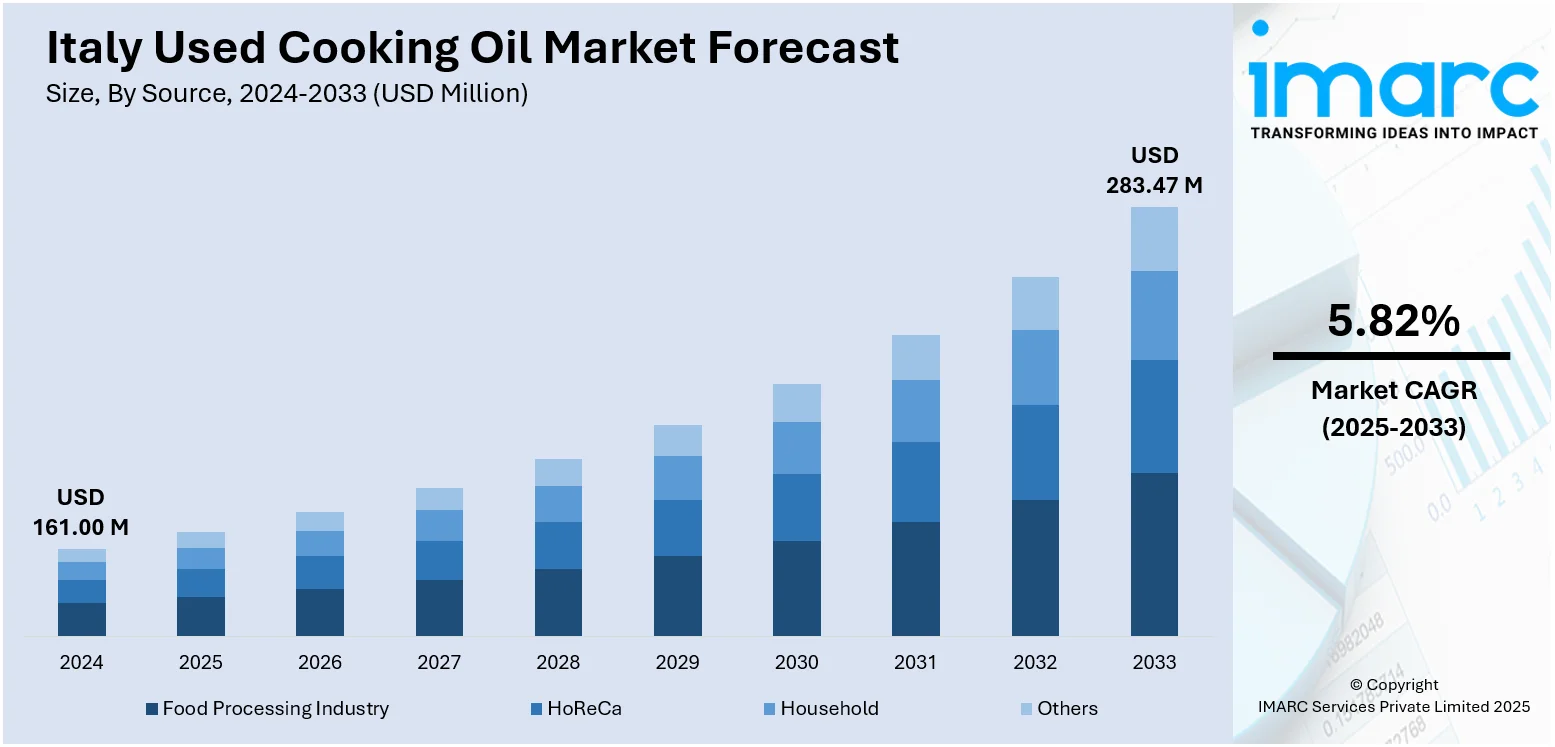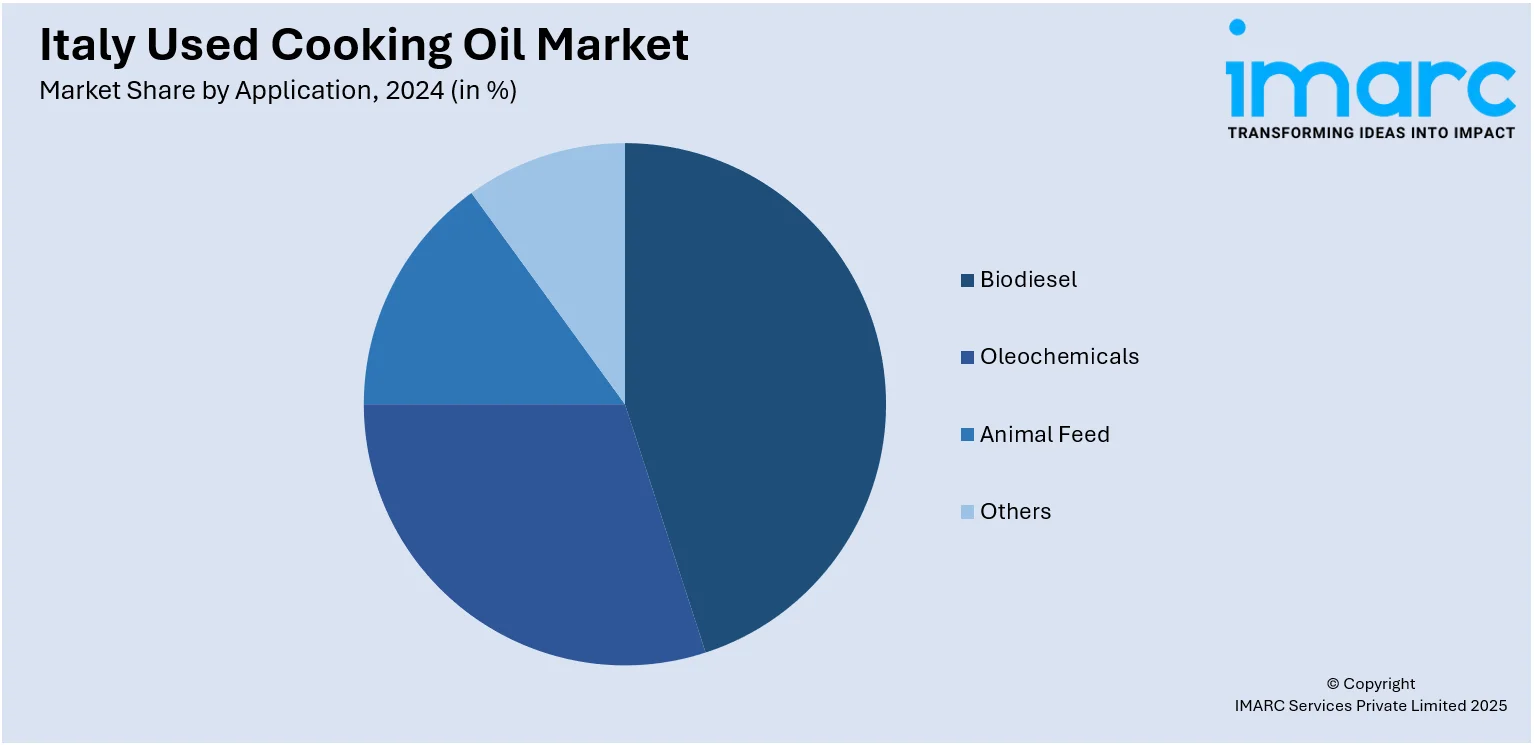
Italy Used Cooking Oil Market Size, Share, Trends and Forecast by Source, Application, and Region, 2025-2033
Italy Used Cooking Oil Market Overview:
The Italy used cooking oil market size reached USD 161.00 Million in 2024. The market is projected to reach USD 283.47 Million by 2033, exhibiting a growth rate (CAGR) of 5.82% during 2025-2033. Environmental regulations in Italy mandate proper disposal and recycling of waste oils to prevent water pollution and sewer blockages, encouraging foodservice operators to collaborate with certified collectors and recyclers. Besides this, the broadening of supermarkets, hypermarkets, and convenience stores is contributing to the expansion of the Italy used cooking oil market share.
|
Report Attribute
|
Key Statistics
|
|---|---|
|
Base Year
|
2024
|
|
Forecast Years
|
2025-2033
|
|
Historical Years
|
2019-2024
|
| Market Size in 2024 | USD 161.00 Million |
| Market Forecast in 2033 | USD 283.47 Million |
| Market Growth Rate 2025-2033 | 5.82% |
Italy Used Cooking Oil Market Trends:
Increasing applications in foodservice industry
Rising applications of used cooking oil in the foodservice industry are propelling the market growth in Italy. Italy’s rich culinary culture, combined with a strong dining-out tradition and a thriving hospitality sector, results in significant volumes of cooking oil consumption, particularly for fried and prepared dishes. As the foodservice industry is innovating in the country, fueled by tourism activities, urban lifestyle changes, and high demand for ready-to-serve meals, the quantity of used cooking oil available for collection is increasing proportionally. Environmental regulations in Italy mandate proper disposal and recycling of waste oils to prevent water pollution and sewer blockages, encouraging foodservice operators to collaborate with certified collectors and recyclers. This collected used cooking oil is then refined into biodiesel, soaps, and other industrial products, supporting both the renewable energy sector and circular economy initiatives. Additionally, the growing environmental awareness among individuals and businesses is enabling the development of more structured oil collection systems, making the foodservice sector a reliable and consistent source of raw material for recycling. With continuous growth in Italy’s hospitality and dining sectors, the steady generation of used cooking oil from foodservice operations will remain a key driver of supply, meeting rising demand from biodiesel producers and other end-users. As per the IMARC Group, the Italy foodservice market is set to attain USD 150.71 Billion by 2033, exhibiting a growth rate (CAGR) of 5.70% during 2025-2033.

To get more information on this market, Request Sample
Broadening of retail outlets
The expansion of retail channels is fueling the Italy used cooking oil market growth. According to the National Institute of Statistics (ISTAT), in June 2025, retail sales in Italy rose by 1% compared to June 2024. As supermarkets, hypermarkets, and convenience stores are broadening their presence, many are integrating used cooking oil drop-off stations, making it easier for households to dispose of cooking oil responsibly. This accessibility is encouraging higher collection volumes from domestic sources, complementing the supply from restaurants and foodservice establishments. Retail chains are also partnering with recycling companies and biodiesel producers to promote awareness campaigns, educating people about the environmental and economic benefits of recycling used cooking oil. These initiatives help reduce improper disposal into drains, which can harm water systems and increase municipal maintenance costs. Additionally, retail-driven collection programs support the circular economy by ensuring that used cooking oil is processed into biodiesel and other value-added products. The retail sector’s extensive network, combined with the growing public awareness and regulatory compliance, is creating a reliable, structured supply chain for used cooking oil. As retail expansion continues across Italy, particularly in urban and suburban areas, the role of these outlets in facilitating collection and boosting supply will remain critical to meeting the rising demand from the biodiesel industry.
Italy Used Cooking Oil Market Segmentation:
IMARC Group provides an analysis of the key trends in each segment of the market, along with forecasts at the country and regional levels for 2025-2033. Our report has categorized the market based on source and application.
Source Insights:
- Food Processing Industry
- HoReCa
- Household
- Others
The report has provided a detailed breakup and analysis of the market based on the source. This includes food processing industry, HoReCa, household, and others.
Application Insights:

- Biodiesel
- Oleochemicals
- Animal Feed
- Others
A detailed breakup and analysis of the market based on the application have also been provided in the report. This includes biodiesel, oleochemicals, animal feed, and others.
Regional Insights:
- Northwest
- Northeast
- Central
- South
- Others
The report has also provided a comprehensive analysis of all the major regional markets, which include Northwest, Northeast, Central, South, and others.
Competitive Landscape:
The market research report has also provided a comprehensive analysis of the competitive landscape. Competitive analysis such as market structure, key player positioning, top winning strategies, competitive dashboard, and company evaluation quadrant has been covered in the report. Also, detailed profiles of all major companies have been provided.
Italy Used Cooking Oil Market News:
- In January 2025, Enilive declared the launch of its inaugural facility to manufacture sustainable aviation fuel (SAF) at the Gela biorefinery in Sicily, Italy. Production commenced at the plant, which could produce 400,000 Tons annually, accounting for nearly one-third of the projected European SAF demand in 2025. The Gela biorefinery could process 736,000 Tons of biomass annually, mainly sourced from waste and residual materials like used cooking oils, animal fats, and by-products from vegetable oil production.
Italy Used Cooking Oil Market Report Coverage:
| Report Features | Details |
|---|---|
| Base Year of the Analysis | 2024 |
| Historical Period | 2019-2024 |
| Forecast Period | 2025-2033 |
| Units | Million USD |
| Scope of the Report |
Exploration of Historical Trends and Market Outlook, Industry Catalysts and Challenges, Segment-Wise Historical and Future Market Assessment:
|
| Sources Covered | Food Processing Industry, HoReCa, Household, Others |
| Applications Covered | Biodiesel, Oleochemicals, Animal feed, Others |
| Regions Covered | Northwest, Northeast, Central, South, Others |
| Customization Scope | 10% Free Customization |
| Post-Sale Analyst Support | 10-12 Weeks |
| Delivery Format | PDF and Excel through Email (We can also provide the editable version of the report in PPT/Word format on special request) |
Key Questions Answered in This Report:
- How has the Italy used cooking oil market performed so far and how will it perform in the coming years?
- What is the breakup of the Italy used cooking oil market on the basis of source?
- What is the breakup of the Italy used cooking oil market on the basis of application?
- What is the breakup of the Italy used cooking oil market on the basis of region?
- What are the various stages in the value chain of the Italy used cooking oil market?
- What are the key driving factors and challenges in the Italy used cooking oil market?
- What is the structure of the Italy used cooking oil market and who are the key players?
- What is the degree of competition in the Italy used cooking oil market?
Key Benefits for Stakeholders:
- IMARC’s industry report offers a comprehensive quantitative analysis of various market segments, historical and current market trends, market forecasts, and dynamics of the Italy used cooking oil market from 2019-2033.
- The research report provides the latest information on the market drivers, challenges, and opportunities in the Italy used cooking oil market.
- Porter's five forces analysis assist stakeholders in assessing the impact of new entrants, competitive rivalry, supplier power, buyer power, and the threat of substitution. It helps stakeholders to analyze the level of competition within the Italy used cooking oil industry and its attractiveness.
- Competitive landscape allows stakeholders to understand their competitive environment and provides an insight into the current positions of key players in the market.
Need more help?
- Speak to our experienced analysts for insights on the current market scenarios.
- Include additional segments and countries to customize the report as per your requirement.
- Gain an unparalleled competitive advantage in your domain by understanding how to utilize the report and positively impacting your operations and revenue.
- For further assistance, please connect with our analysts.
 Request Customization
Request Customization
 Speak to an Analyst
Speak to an Analyst
 Request Brochure
Request Brochure
 Inquire Before Buying
Inquire Before Buying




.webp)




.webp)












